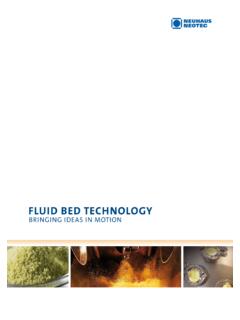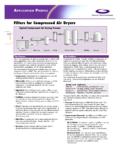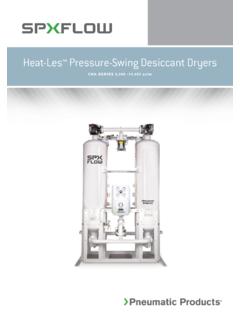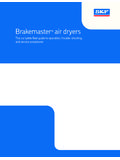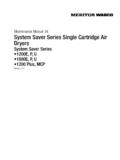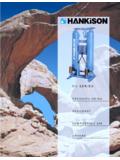Transcription of Regenerative Desiccant Dryers - Home – Ottawa …
1 KAD, KED and KBD SeriesRegenerative Desiccant DryersWhy Desiccant Air Dryers ? Desiccant Dryers provide extremely dry air. For applications where ambient conditions require dew points below freezing and as low as -100 F, Kaeser Compressors has the right s Desiccant Dryers are twin tower Regenerative Dryers . Standard sizes range from 5 cfm to 5400 cfm with larger models also highly-effective units combine an adsorption drying process using activated alumina with choices in the regen-eration method. Our Desiccant dryer line includes: Heatless Desiccant Dryers (KAD and KADW series) Heated purge Desiccant Dryers (KED series) Heated blower purge Desiccant Dryers (KBD series)Careful evaluation and planning is essential for an efficient clean air treatment system.
2 Desiccant dryer selection should be based on specified dew points and energy saving capabilities. These Dryers should only be applied to portions of the com-pressed air system that require dew points below 35 F. Because Desiccant Dryers require a higher initial investment and higher overall operating costs, Kaeser strongly recommends using refrigerated Dryers whenever practical. However, when Desiccant Dryers are needed, evaluate all three designs with respect to initial cost vs. electrical operating cost. Significant energy savings are possible in many OperationKaeser Desiccant Dryers employ the principles of adsorption and desorp-tion to produce a continuous supply of dry compressed air.
3 Desiccant materials have a high surface-to-volume ratio and great affinity for water vapor. Adsorption occurs until the vapor pressure of water on the Desiccant and the com-pressed air reaches equilibrium. The water vapor condenses on the desic-cant surface and heat is released. During regeneration, purge air flowing through the tower of wet Desiccant evaporates water on the Desiccant and carries it out of the tower as vapor. There are three basic sources of purge air for regenerating a wet Desiccant bed, they are.
4 KAD - dried compressed air reduced to near atmospheric pressure ( of dryer capacity when operating at 100 psig) KED - dried compressed air reduced to near atmospheric pressure and heated to 375 F (6% to 7% of dryer capacity when operating at 100 psig) KBD - ambient air heated to 375 FTotal Cost to Dry 3000 cfm(includes purchase and yearly electrical costs)Year$400k$350k$300k$250k$200k$150k $100k$50k$0 Based on $ , 24 hr/day, 365 days/yr operationHeatless Desiccant dryer (KAD)Heated Purge Desiccant dryer (KED)Blower Purge Desiccant dryer (KBD)CrossoverThe chart above compares the combined purchase and electrical costs for three types of Desiccant dry-ers sized to dry 3000 cfm.
5 It shows that the efficiencies of heated Dryers quickly pay back their initially higher investment (within 2 to 3 years). The crossover point between heated Dryers (KED and KBD) occurs within 3 years. Payback calculations are directly tied to the volume of air being dried. Generally, the larger the volume being dried the shorter the payback period. The operating cost for regeneration in the KAD, KED and KBD are approximately $54,000, $41,000 and $37,000 1 2 3 4 5 Desiccant SelectionAll Kaeser Desiccant Dryers use spherical activated alumina Desiccant for adsorption.
6 Activated alumina has a high static adsorption capacity (42% by weight), a high abrasion resistance and crush strength and maintains its physical integrity in the presence of liquid water. These characteristics allow for long service life and minimize dusting. Because the Desiccant is not altered by the adsorption process, the cycle of adsorption and desorption can be repeated many thousands of times before the Desiccant needs replacing. Desiccant Bed DesignKaeser Regenerative Dryers have large Desiccant beds to ensure consistent outlet dew point performance and compensate for the effects of natu-ral Desiccant aging (which reduces adsorptive capacity).
7 Desiccant bed symmetry is selected to assure uni-form flow distribution and maximize contact RegenerationKaeser s up flow drying and down flow regen-eration extends Desiccant service life and assures consistent outlet dew counter flow arrangement also controls the accumulation of liquid water in the Desiccant beds. Regardless of design, liquid water will accumulate in the piping between the prefilters and the dryer inlet. Eventually, the air stream will carry a slug of water into the Desiccant bed. In down-flow Dryers this water percolates down through the Desiccant toward the dry end of the bed resulting in degrada-tion and poor dryer the countercurrent design, gravity and low velocities allow moisture to settle in the bottom of the Desiccant vessel, where it is safe-ly discharged from the system when the tower depressurizes for regeneration.
8 This design also ensures that the driest portion of the Desiccant bed is nearest the dryer outlet at switchover, and allows purge air to be evenly distributed throughout the Desiccant bed, providing more effective ValvesDesiccant dryer performance and reli-ability are driven by component qual-ity. Kaeser Dryers are fitted with the most reliable valves and actuators. Designed to hold up under the harsh-est operating conditions year after year, these leak-free switching valves ensure consistent dew point perfor-mance and low pressure drop.
9 Direct acting solenoid switching valve Butterfly valve with rack and pinion actuator How it WorksThe dryer alternately cycles the compressed air flow through twin Desiccant towers. As the vapor-laden air enters and flows upward through one tower, the moisture is adsorbed onto the Desiccant . Clean, dry air flows from the dryer downstream into the compressed air system. While one Desiccant chamber is in the drying cycle, the other chamber goes through a regeneration cycle. Three methods of regenera-tion are available.
10 KAD Dryers use a portion of the dry outlet air (about 15%), which is reduced in pressure through an orifice, further reducing its dew point. This extremely dry air, aided by the heat of adsorption, regenerates the Desiccant . KED Dryers use a smaller portion of dry outlet air (about 7%), which is also reduced in pressure through an orifice and then heated to 375 F. This hot, extremely dry, air is passed through the bed regenerating the Desiccant . Nylon shuttle valve KBD Dryers use a Regenerative blower to move ambient air through a heater where its temperature is increased to 375 F, and then through the bed, regenerating the Desiccant .

